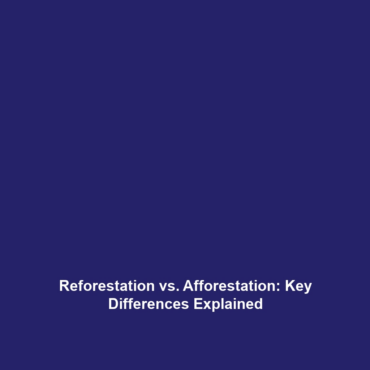The Difference Between Reforestation and Afforestation
Deforestation and biodiversity loss are crucial challenges facing our planet today. Understanding the difference between reforestation (restoring native forests) and afforestation (planting trees in areas that were not previously forested) is essential for effective environmental conservation. Both practices play a significant role in addressing the devastating impacts of deforestation and enhancing biodiversity. This article delves into these two approaches, their implications, and their importance in the quest for ecological sustainability.
Key Concepts
To comprehend the significance of reforestation and afforestation, it’s vital to explore their definitions and relevance to the broader context of deforestation and biodiversity loss.
What is Reforestation?
Reforestation involves replanting trees in areas where forests have been depleted, thereby restoring the native ecosystem. This practice often enhances local biodiversity, stabilizes soil, and improves the overall health of the environment.
What is Afforestation?
In contrast, afforestation refers to the establishment of forests in regions that were not previously forested. While this can help increase carbon sequestration and combat climate change, it may not always enrich local biodiversity if non-native species are introduced.
Applications and Real-World Uses
Understanding the difference between reforestation and afforestation is key to implementing effective environmental strategies. Here are some ways these practices are applied effectively:
- Carbon Sequestration: both methods can significantly reduce carbon dioxide levels in the atmosphere.
- Soil Restoration: reforestation leads to healthier soil quality, while afforestation can prevent soil erosion in barren land.
- Habitat Restoration: reforestation nurtures native fauna and flora, enhancing biodiversity.
Current Challenges
Despite the benefits of both reforestation and afforestation, there are challenges that hinder their implementation:
- Ecological Suitability: Afforestation in inappropriate areas may disrupt existing ecosystems.
- Species Selection: Specific tree species may not adapt well to the new environment, affecting biodiversity.
- Long-term Maintenance: Both practices require ongoing care and management to ensure their success.
Future Research and Innovations
The future of reforestation and afforestation holds promise with several innovations on the horizon:
- Biotechnology: Advances in genetic engineering may enable the development of resilient tree species.
- Remote Sensing Technology: This can enhance monitoring and management strategies for reforestation and afforestation projects.
- Community Engagement: Innovative programs encouraging local participation can improve the success rates of tree planting initiatives.
Conclusion
The differences between reforestation and afforestation are fundamental to addressing the critical issues of deforestation and biodiversity loss. Understanding these concepts enables better environmental management and policy-making. As we move forward, it is imperative to support practices that not only restore our forests but also enhance biodiversity. For more information on sustainable environmental practices, visit our pages on forest preservation and biodiversity conservation.

